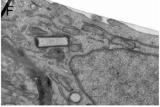
One important consideration in the development of nanotechnology is the ability to create nanoparticles with highly controllable characteristics that can be changed one at a time in order to elucidate the importance of each characteristic on the nanoparticle behavior in various environments. For example, the nature of the nanoparticle surface will affect how readily the nanoparticle will adsorb to or be repelled by a given surface or material. Researchers from the University of North Carolina Chape Hill and North Carolina State University have recently reported on the effect of nanoparticle characteristics such as size, shape, and surface chemistry on the readiness of these nanoparticles to transport into human cervical carcinoma epithelial (HeLa) cells.
These researchers were able to study the interdependent effect of particle size, shape and surface chemistry with uniform nanoparticles fabricated using a top-down approach called PRINT (Particle Replication In Non-wetting Templates). With this process, they were able to create extremely uniform particles with the following sizes and shapes:
• cubes with two to five micron edges,
• cylinders with half to one micron diameters and one micron height,
• cylinders with 100-200 nanometer diameters and 200-450 nanometer heights.
Production of such uniform sizes and shapes are difficult if not impossible using some bottom-up fabrication methods. The size and shape in the accompanying photo had the fastest rate of uptake into HeLa cells.
Examining the rates of uptake of these particles into HeLa cells, these researchers reported on several interesting findings: 1) particles as large as 3 microns could be taken up by the cells, an order of magnitude larger than previously thought possible, 2) the highest rate of particle uptake was seen for those with a small size and large aspect ratio, 3) positively charged particles were significantly more likely to be taken up by cells than those with negatively charged surfaces when size and shape were held constant.
The literature includes much research on the behavior of nanoparticles in given environments, but frequently the results are conflicting or not comparable due to differences in the materials and fabrication methods from laboratory to laboratory, batch to batch, and even within a given batch. This study serves as a good example of changing nanoparticle characteristics one at a time – a method needed to accurately determine the behavior of nanoparticles in various environments. This type of method can be applied to fundamental studies of nanoparticle behavior and transport in biological and non-biological systems, the study of environmental, health and safety effects of nanoparticles, as well as the development of drug-delivery mechanisms.
Supporting information can be found here.
Additional information at nanowerk.
Image from Gratton, S.E.A., Ropp, P.A., Pohlhaus, P.D., Luft, J.C., Madden, V.J., Napier, M.E., DeSimone, J.M. “The effect of particle design on cellular internalization pathways” PNAS 2008, 105, 11613. Reprinted with permission from PNAS.
